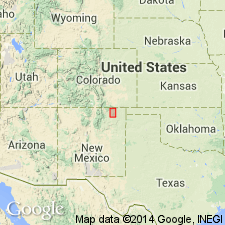
- Usage in publication:
-
- Slagle Trachytes
- Modifications:
-
- Not used
Summary:
Oligocene trachyte was called Slagle Trachytes by Collins (1949), a term not used in this report. Las Vegas-Raton basin. K-Ar determination on hornblende in map unit yielded an age of 36.7 +/-1.3 m.y.
Source: GNU records (USGS DDS-6; Denver GNULEX).

- Usage in publication:
-
- Slagle Trachyte*
- Modifications:
-
- Geochronologic dating
- Overview
- AAPG geologic province:
-
- Las Vegas-Raton basin
Summary:
Is oldest igneous rock unit (of eight) of the Chico sill complex mapped in western part of Raton-Clayton volcanic field, Colfax Co, NM in Las Vegas-Raton basin. Although Collins (1949) named the Slagle for outcrops on the east side of Slagle Canyon of Rio del Plano 1 mi north of Maxwell-Chico road, the only trachyte here is on west side of canyon. Type area herein considered to be exposures on the west side of Slagle Canyon in SW1/4 sec 34, T27N, R25E, Colfax Co, NM. Is light-olive-gray, hard, porphyritic rock having numerous prominent hornblende phenocrysts set in gray, finely crystalline groundmass. Weathers pervasively; is pale orange, dark yellowish gray, or brown; black hornblende crystals, as large as 8 mm, alter to pale-brown iron oxide. Flow structure is well displayed by hornblende crystals in dikes and sills. Petrography and petrochemistry described. K-Ar age reported by Staatz (1985) as 36.7 +/-1.3 m.y. Age is Oligocene.
Source: GNU records (USGS DDS-6; Denver GNULEX).
For more information, please contact Nancy Stamm, Geologic Names Committee Secretary.
Asterisk (*) indicates published by U.S. Geological Survey authors.
"No current usage" (†) implies that a name has been abandoned or has fallen into disuse. Former usage and, if known, replacement name given in parentheses ( ).
Slash (/) indicates name conflicts with nomenclatural guidelines (CSN, 1933; ACSN, 1961, 1970; NACSN, 1983, 2005, 2021). May be explained within brackets ([ ]).

